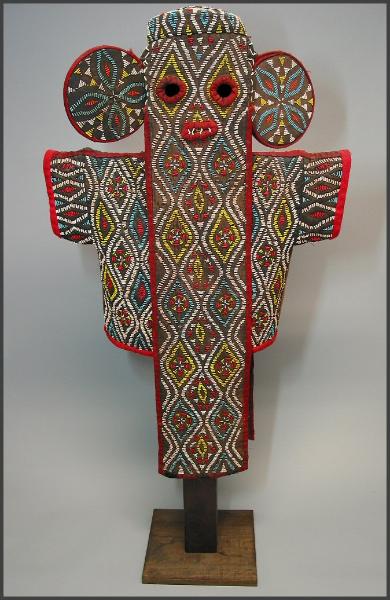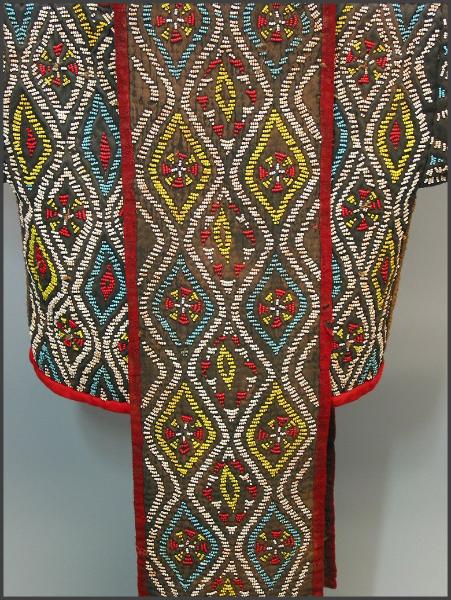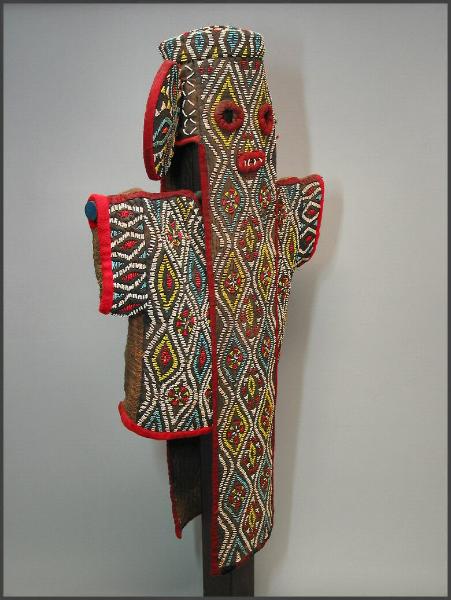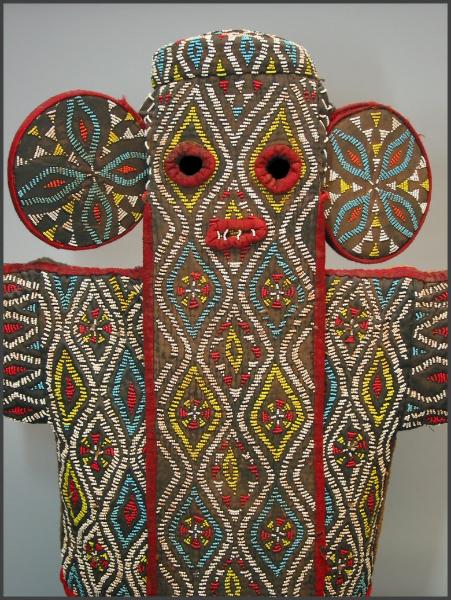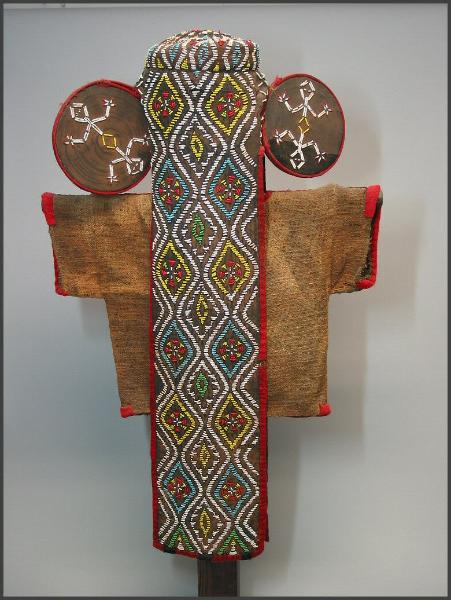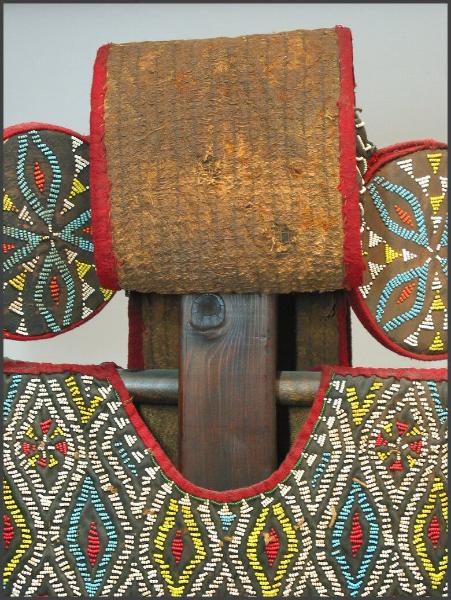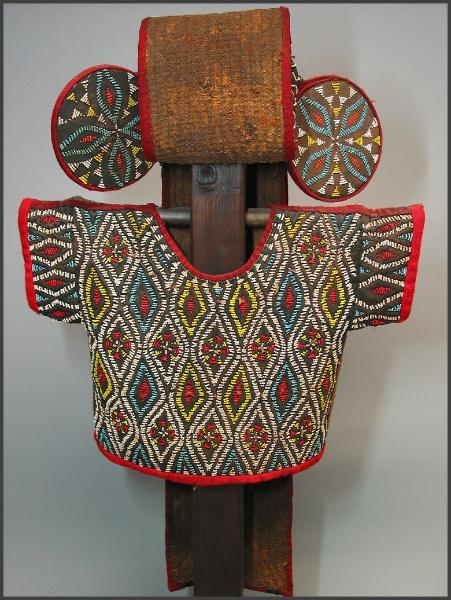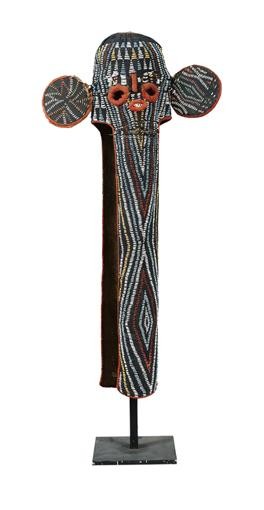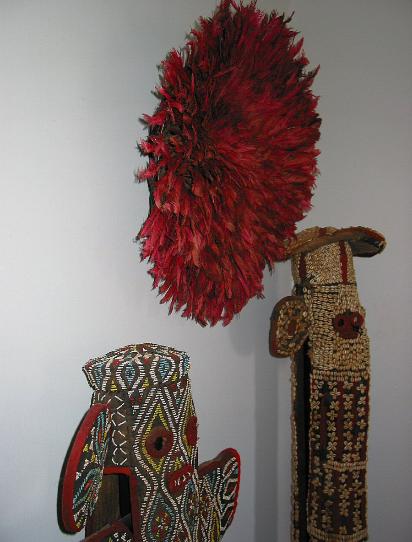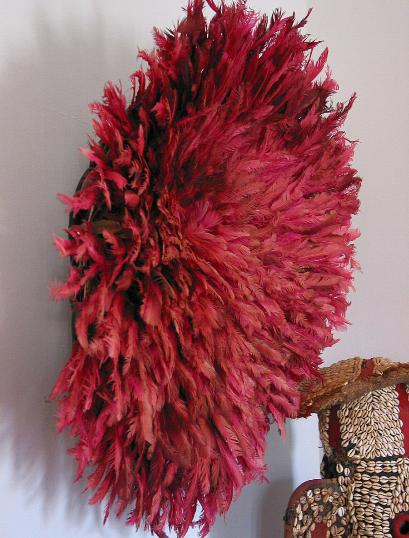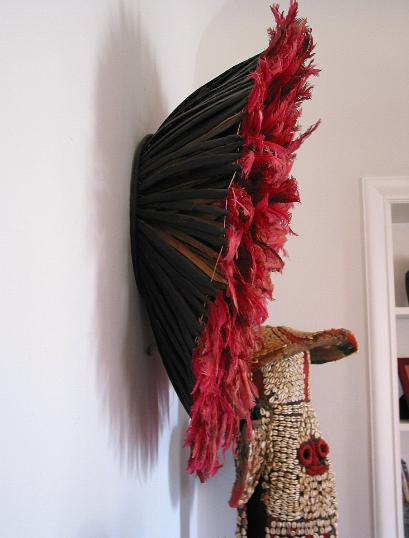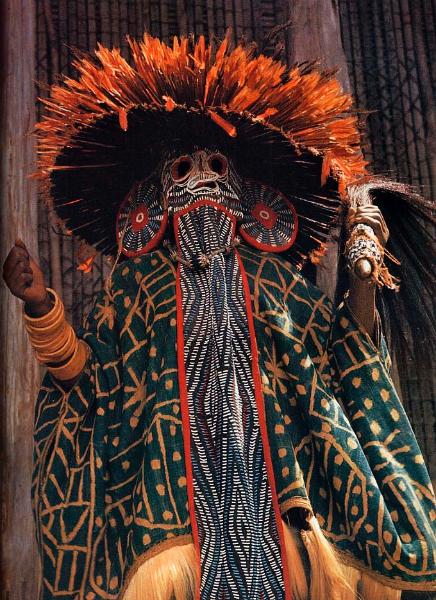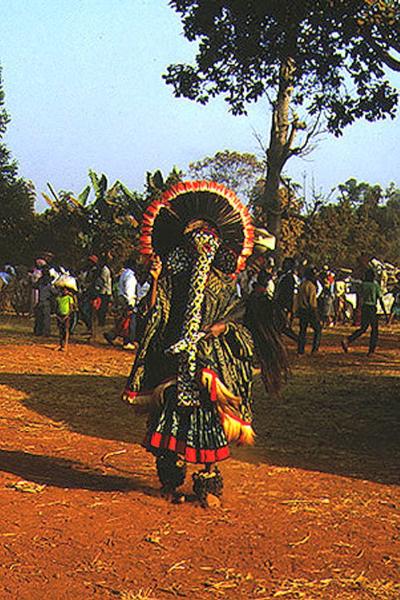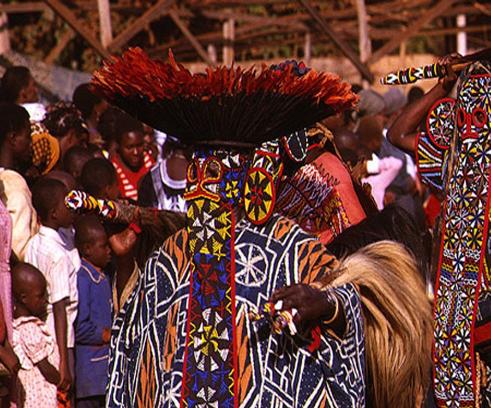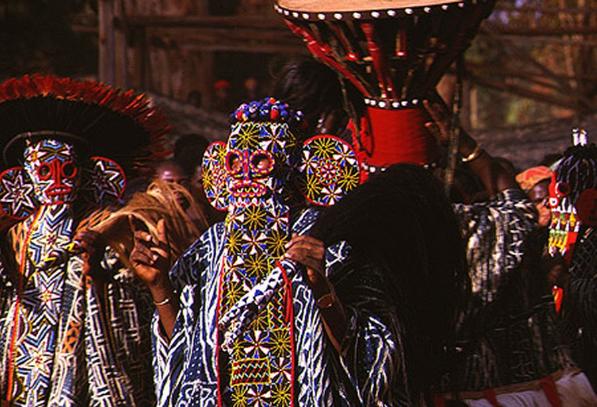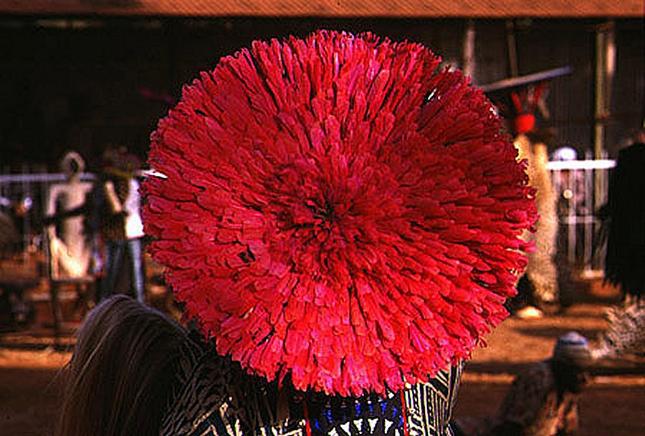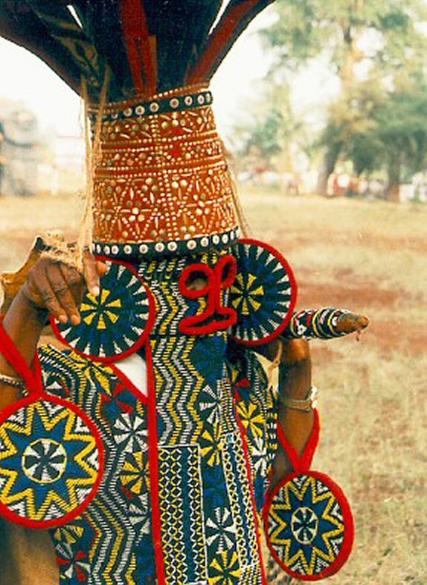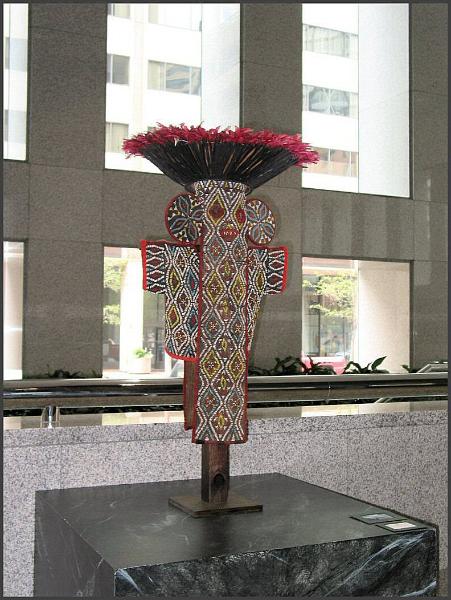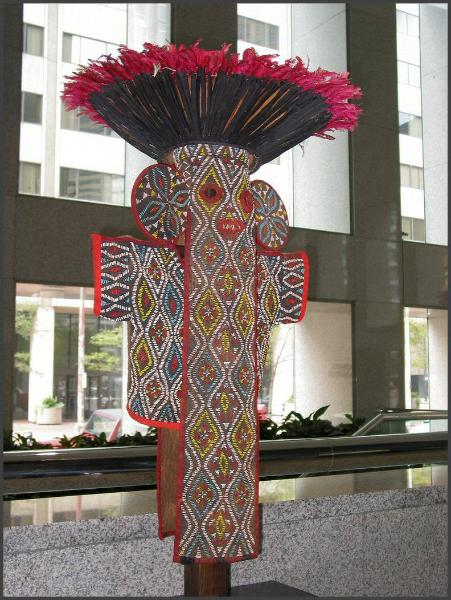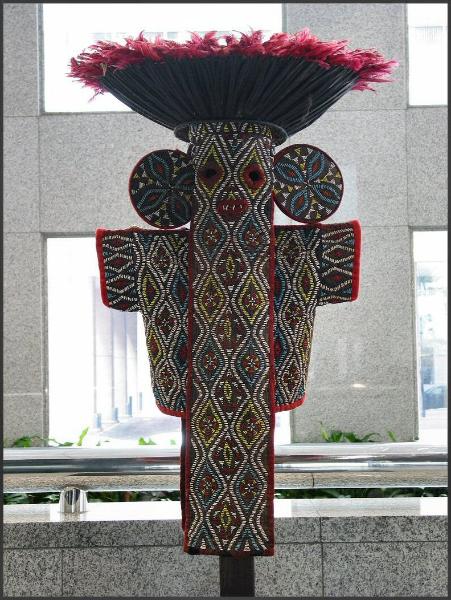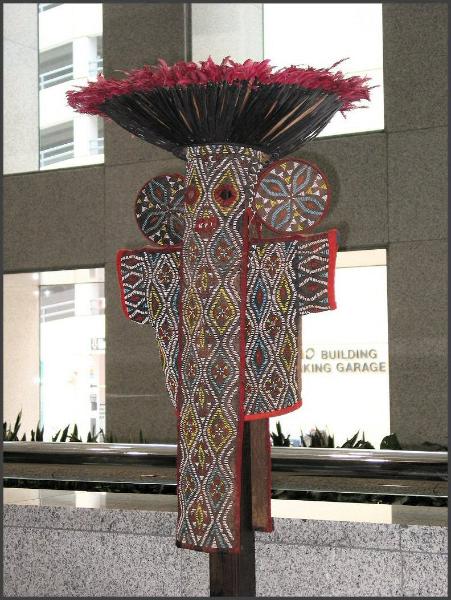
| Bamileke Elephant masks Cameroon |
| The king and Kuosi society members in Bandjoun 1930 |
| Bamileke elephant masks Elephants are the world's most commanding land creatures, unsurpassed in grandeur and power. Thus elephant masks, while rare in Africa, are fully appropriate symbols of important leaders or, at least, their respected deputies or messengers. The societies that use these masks in fact act as agents of chiefs' control and as formal royal emissaries. Elephant societies that originated in Bamileke and spread elsewhere in the Grasslands consist of three graded ranks attained by wealth. These elephant masks, signifying kingship and wealth, were worn by the powerful members of the Kuosi regulatory society, which included members of royalty, wealthy title holders, and ranking warriors of the Bandjoun kingdom of western Cameroon. In the past, payment of a slave or a leopard pelt to the chief who owns the society was necessary for entrance to the highest rank. The glass beads used on earlier masks were nineteenth-century trade beads of Venetian or Czechoslovakian manufacture, used as well in exchange for slaves. Elephant mask costumes were thus called "things of money" since their beads were both objects and symbols of wealth (Brain and Pollock 1971:100; Northern 1975:17-21). Elephant masks comprise cloth panels and hoods woven from plantain fiber over raffia. On this background multicolored beads are stitched in geometric patterns. The basic form depicts salient features of the elephant—a long trunk and large ears. The hood fits tightly over the masker's head, and two hanging panels, one behind and one in front, partially conceal the body. The front panel is the elephant trunk, and the two large, stiff circles hinged to either side of the head are its ears, which flap as the masker dances. While the mask symbolizes an elephant, the face is human. Eyeholes provide visibility, and a nose and mouth with teeth are normally present. Such masks are often worn with robes of dark woven fiber covered with small fiber knobs or indigo and white tie-dyed "royal" cloth. The robes contrast greatly with the maskers' bright red legs, dyed with camwood. Costumes also include beaded vests with broad belts and leopard pelts attached at the back. Since a chief owns or controls the masking society, both leopards and elephants are apt metaphors for symbolic impersonation. Maskers dance barefoot in these colorful costumes to a drum and gong, moving slowly as they wave poles with blue and white beaded tips trimmed with horsehair. They whistle "mysteriously and tunelessly," brandishing spears and horsetails. Maskers are later joined by chiefs and princesses, parading by an elaborate tent in which high-ranking men sit to observe. A masker hurls his horsetail to the chief, the crowd cheers, and the celebration continues with various feats performed primarily by younger maskers. When the festivities end, the favorites are rewarded with kola nuts and wine (Brain and Pollock 1971:100-104; Northern 1975:17). The beauty of these masks is largely in their colorful beaded patterns. Dark blue or red backgrounds provide foundations for basic geometric designs laid out in white, creating a striking contrast. As Tamara Northern indicates, the masks show varied degrees of order and complexity (1975:116).33 Masks may be sparsely or densely beaded. The mask's lavish use of colored beads and cowrie shells displayed the wealth of the members of the Kuosi society; and its colors and patterns expressed the society's cosmic and political functions. Cowrie shells are also symbols of wealth and power and were used in the some examples of these masks. Black denotes the relationship between the living and the dead. White refers to the ancestors and potent medicines. Red symbolizes life, women, and the institution of kingship. The dominant triangle designs on both masks represent leopard spots, the leopard being a royal symbol of power and mastery like the elephant. The members of the Kuosi regulatory society belonged to the royal court and enforced the laws of the kingdom in all spheres of life. The society gathered together during funeral ceremonies of its members and for public celebrations of kingship to display the Bandjoun kingdom's power and wealth. Source: Sign of the Leopard - Beaded Art of Cameroon The elephant masks of the Bamileke At the head of the highly structured Bamileke chiefdoms is a fon. He is assisted by a council composed of eight men, patrilineal descendents of the founders of the kingdom. The mkem, or assembly of the holders of hereditary rights, includes all the men who have rendered a great service to the kingdom; for example, war chiefs, or men who have enriched the royal treasury with elephant tusks or leopard skins. Each member of the mkem is head of a society with a specialized function: either religious, economic, military, or so on. The members of only two of these societies, the warrior societies of kuosi and kemdje, are allowed to wear the elephant masks and the leopard skins. Ceremonies in which the wealth of the fon is displayed take place on the death of a fon or a man of high rank, or every two years, during the most important meetings of these societies. Every item in the elephant mask costume denotes wealth, power and privilege. The multitude of glass beads which decorate it are ancient barter money, dating back to the slave-trade period. This display of wealth is in fact one of the functions of the mask. The elephant and the leopard are also evocative of force and power, both the power of the animals themselves, masters of the bush, and also that of the fon. For a fon is said to be able to transform himself into an elephant or a leopard. Source: The Dance, Art and Ritual of Africa – Michele Huet |
| Click on any picture to see larger version. |
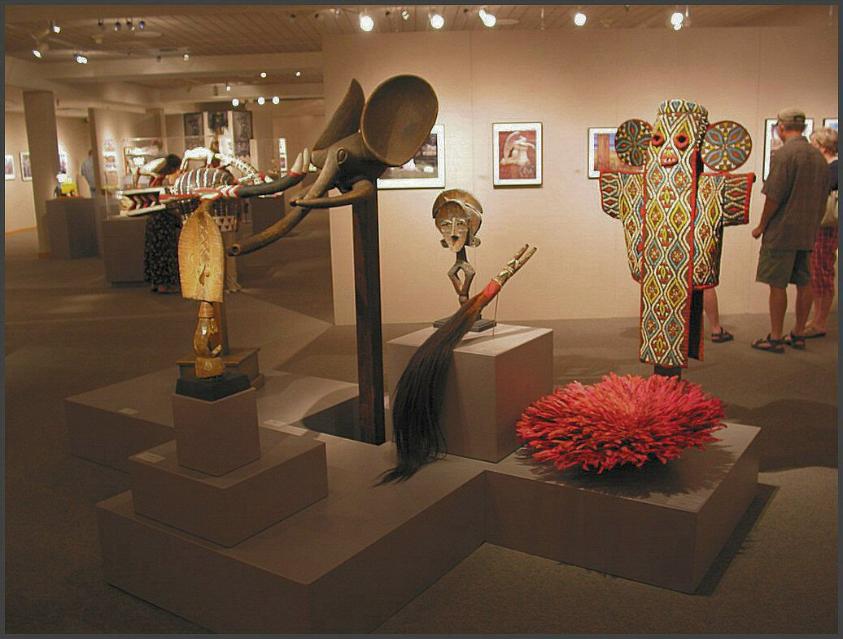
| (Above) This piece was in the exhibition "Grave Matters - The Art of Memory and Mourning" at the Loveland Art Museum in Colorado from May 27th - August 13th 2006 The mask is currently in the exhibition "Native Arts of the World...At Home in Colorado - The Douglas Society Collects" August 25th - October 27th 2006 Photo below was taken at the opening reception |
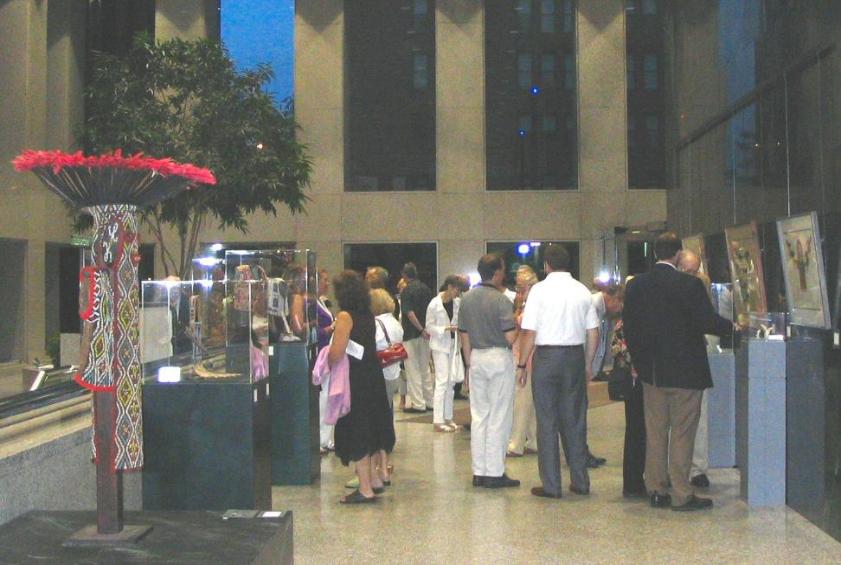
| Bamileke beaded elephant mask with beaded vest - 40" tall |
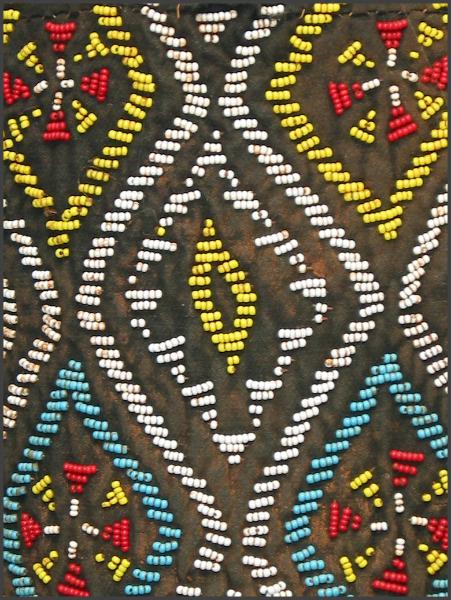
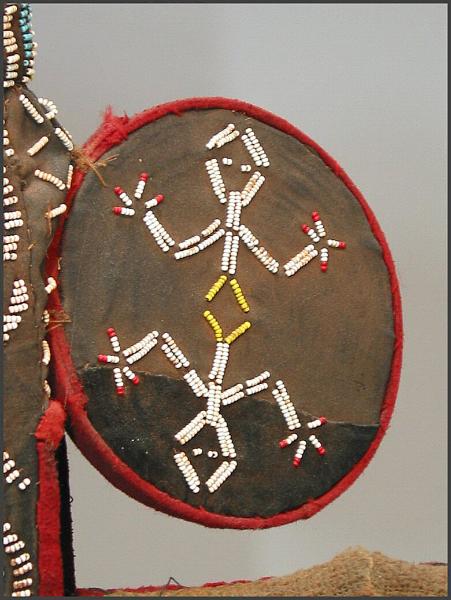
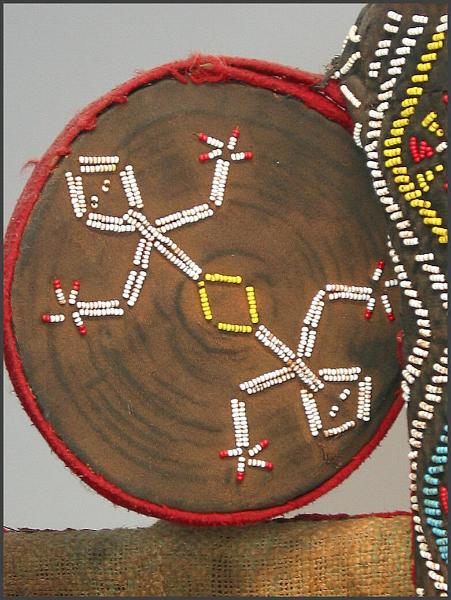
| Other examples for reference purposes |
| Sotheby's - Paris Paolo Morigi collection : Important African Art Auction Date : Jun 6, 2005 Lot 155 : f - MASQUE-CAGOULE ÉLÉPHANT, BAMILÉKÉ, CAMEROUN [A BAMILEKE BEADED ELEPHANT MASK, CAMEROON] Description tou-poum, fait d'une toile de fibres de raphia doublée à l'extérieur d'un tissu noir orné de perles de verre colorées. Les traits anthropomorphes sont ourlés d'une feutrine indigo, les yeux sont ronds, percés. De chaque coté sont cousues de larges oreilles plates, circulaires, rigidifiées par une structure interne. La cagoule se prolonge à l'avant et à l'arrière par un long rabat décoré de motifs de losanges et de triangles formés par des perles multicolores. Dimensions haut. 86 cm 33 2/3 in Estimate:€ 1,500 - € 2,000 Price Realized:€ 3,600 $ 4,337 |

| Sotheby's - New York Arts of Africa, Oceania & The Americas Auction Date : May 17, 2002 Lot 44 : Bamileke elephant mask Description fashioned from cloth in the form of an abstract elephant framed by large flat circular ears, with a panel at the front and back composed of indigo resist dyed cloth and a burlap lining; elaborately beaded overall with yellow, green, white and blue glass beads in geometric patterns. Estimate: $ 6,000 - $ 9,000 Price Realized: $ 0 Provenance Pace Primitive and Ancient Art, New York According to Ross (1992: 246-253), this type of Bamileke mask is associated with men's societies found in most Bamileke chiefdoms: the Kuosi, Nekang and Kem-ndze. The societies perform regulatory functions, with the elephant as their symbol. See Ross (ibid.) for further discussion and related examples in situ. |

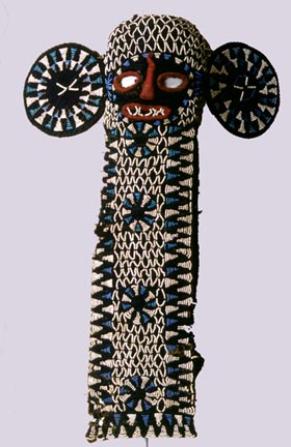
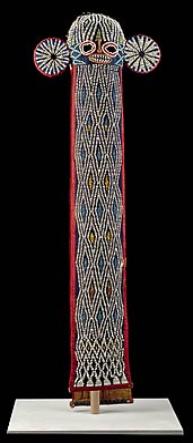
| Bamileke, Cameroon Elephant Society Mask, late 19th century Raffia, canvas embroidered with beads 62 3/4" x 18 1/2" x 8 1/4" Gift of the Director's Council 97.2.1 Memphis Brooks Museum of art |
| Elephant Helmet Mask, about 1950 1970 Bamileke people textile, beads Ball State University Museum of Art |
| Bamileke Title: Elephant Mask Date: c.1900 Medium: Indigo-dyed cotton, glass beads, natural fibers Dimensions: 54 x 8 1/2 in. (137.2 x 21.59 cm) Credit Line:The Christina N. and Swan J. Turnblad Memorial Fund The Minneapolis Institute of Arts |

| Cameroon Grasslands, 20th Century, Colonial Period This mask represents the elephant and the leopard, royal symbols of the king's power and wealth. According to Bamileke legend, the king can transform himself into either of these animals at will. Such a mask would have been worn in a biannual dance by the king and members of the Kuosi association, an elite group of Bamileke men. Dance costumes often included luxury items such as elaborate beaded garments, feathered and sculpted headdresses, indigo-dyed royal cloths and leopard pelts. The large ears and hanging trunk of the mask are indicative of an elephant. Kings are said to have accomplished legendary deeds while in the form of an elephant, such as moving giant trees blocking their way. The king faces similar obstacles as the leader of his people. Not only does the elephant evoke a sense of might and majesty, but their ivory tusks were a source of wealth, exchanged for beads and other goods. The spots of the leopard are reflected in the beadwork patterns. The strength, power, speed, and cunning of the leopard are also characteristics equated with kingship. This mask was generously donated by Richard and Barbara Faletti and is part of the Richard and Barbara Faletti Family Collection of West African Cultural Artifacts. Spurlock Museum, University of Illinois |
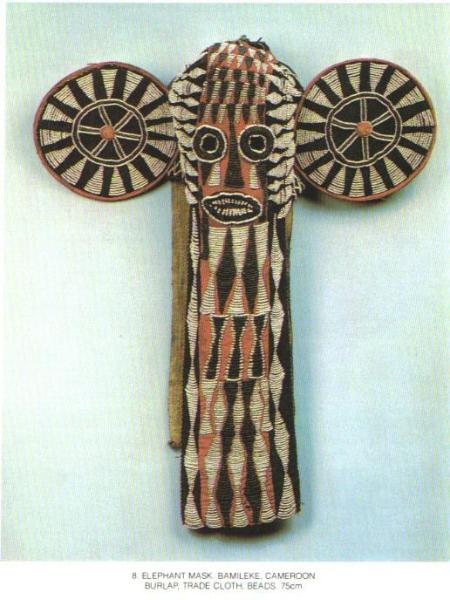
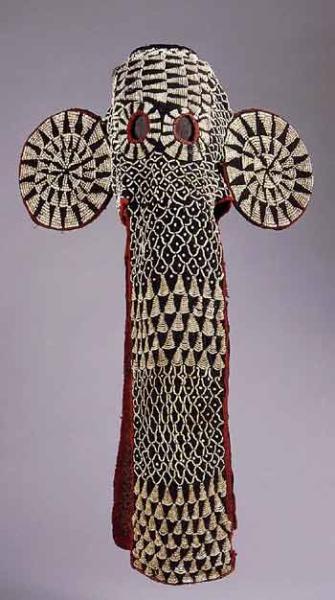
| Denver Art Museum from the collection of Frederick Wolff, Vienna -collected ca. 1880 |
| Museum for African Art |
| Cameroon Bamileke red feather headdress |
| Red feather headdress- red feather headdress which sits on the top of the embroidered fabric Cameroon elephant masks. Used in tribal funerary ceremonies. Each feather quill is encased in a black silky fabric (on the reverse side). Inverts onto itself to form a 13 inch high bundle with 11 1/2 inches across the bottom. Bottom has a leather loop and a coarse rattan type finish (similar to Kuba textiles). Size: 29 inches across x 9 inches high. |
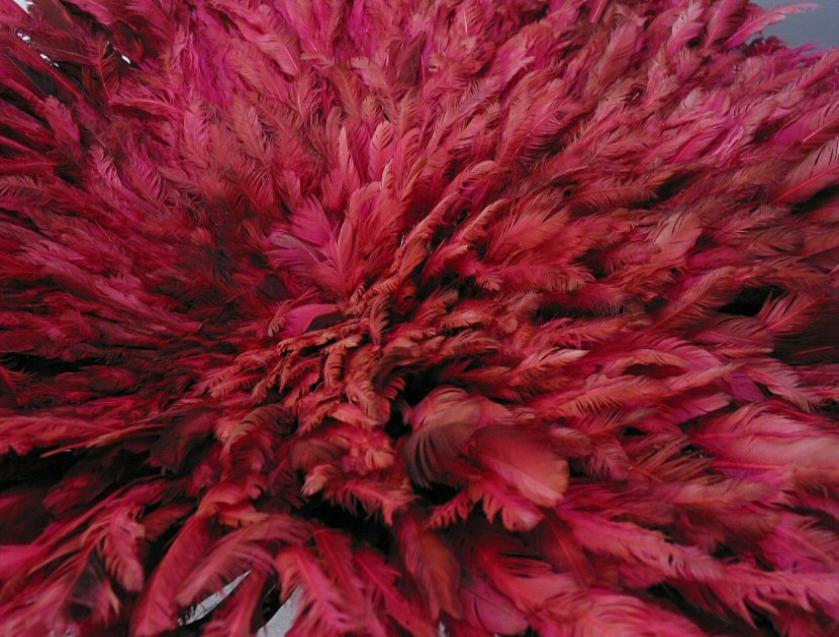
| An example from an "important" collection for reference |
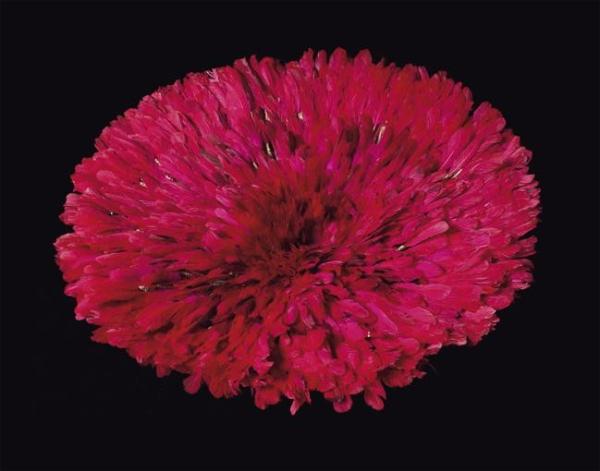
| Sotheby's - Paris Paolo Morigi collection : Important African Art Auction Date : Jun 6, 2005 Lot 131 : f - COIFFURE EN PLUMES, BAMILÉKÉ, CAMEROUN [A BAMILEKE FEATHER HEADDRESS, CAMEROON] Description ten, formée d'une structure en vannerie plantée de baguettes végétales auxquelles sont fixées des plumes d'oiseau teintes en rouge. La longueur des baguettes se fait décroissante à mesure que l'on se rapproche du centre, de manière à offrir, lorsque la coiffe est déployée, un splendide cercle rouge rayonnant. PROVENANCE Collectée sur le terrain vers 1970 Ancienne collection G.F. Keller (inv. GFK 340) CATALOGUE NOTE Apanage du fon, de ses notables, et de quelques dignitaires du royaume, le ten est considéré comme la coiffure de plume la plus prestigieuse du Grassland. Le ten était traditionnellement composé de plumes de perroquet vermillon. Harter (1986 : 149) explique par la raréfaction de cet oiseau, l'utilisation de plus en plus fréquente de plumes plus communes, teintes en rouge. Dimensions diam. 90 cm 35 1/2 in Estimate:€ 2,000 - € 3,000 Price Realized:€ 5,400 $ 6,506 |
| Beaded flywhisk with horse hair. These objects were used in conjunction with the elephant masks. |
The king and Kuosi society members in Bandjoun 1930
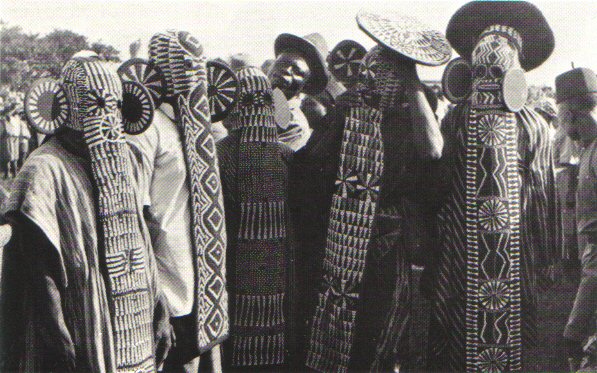
| Cameroon elephant maskers - 1930 Photo Paul Gebaur |

| Bamileke Kuosi elephant masqueraders in full costume |
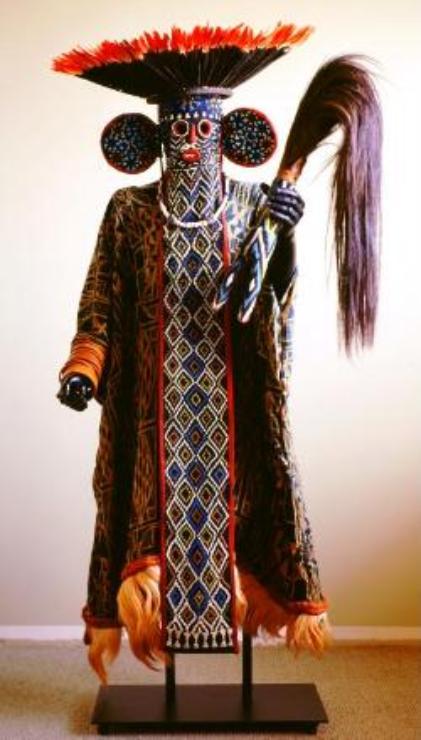
| Go to the Bamileke cowrie shelled elephant mask page Go to the Bamileke elephant/leopard headcrest page |
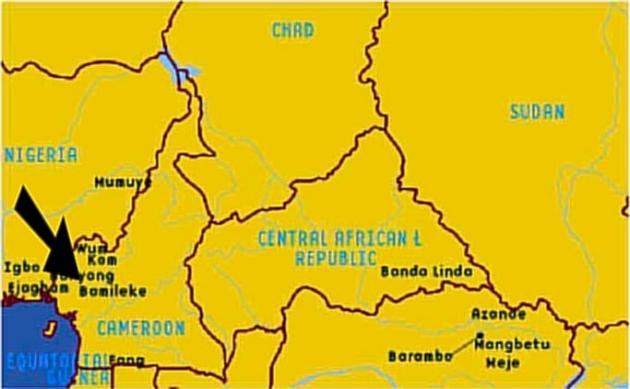
| Below are a few more photos I took at the exhibition. At my house I don't have the room to display it with the feather headdress on it so it was nice to get some photos like this. |

